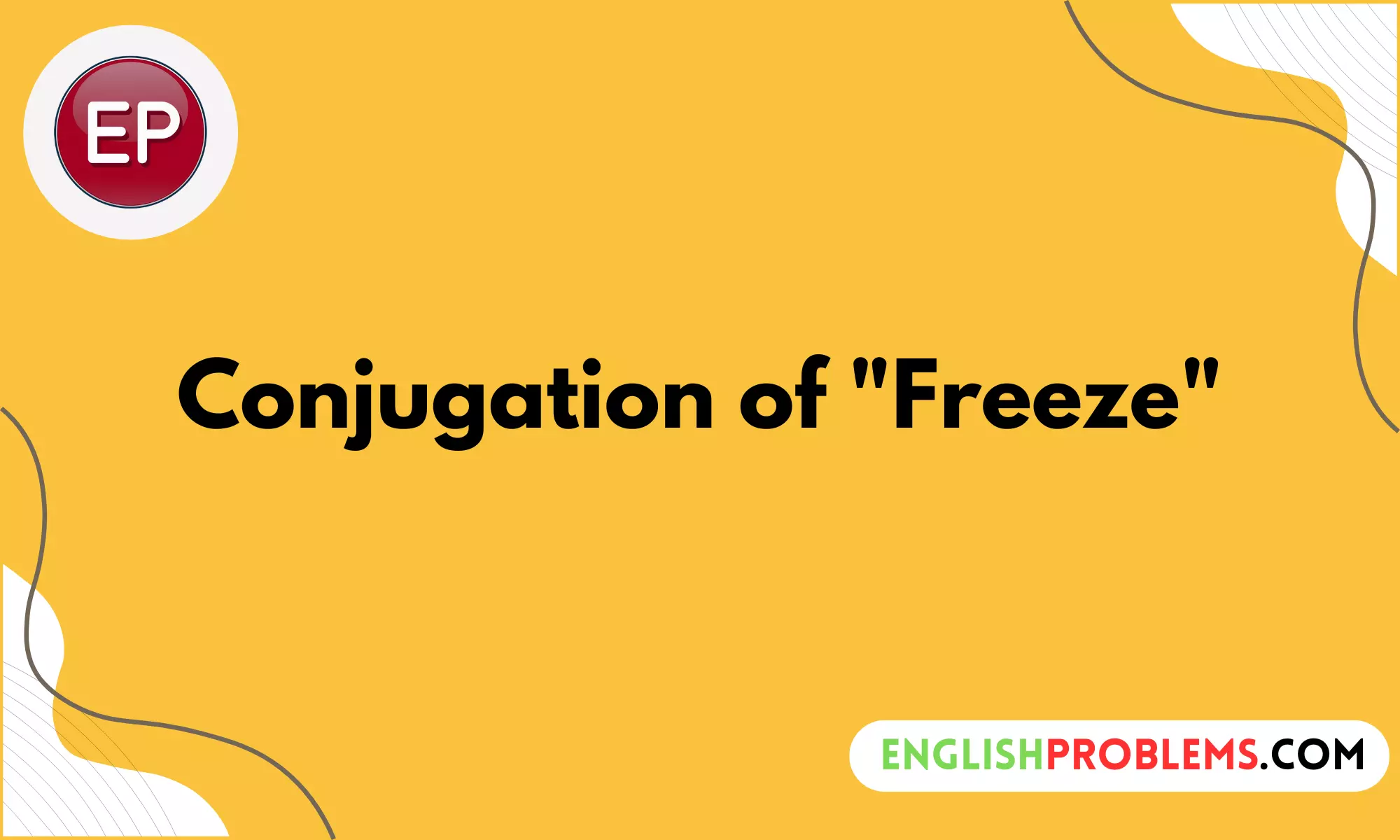The English language is full of intriguing and sometimes perplexing verb forms. One such verb that often causes confusion is “freeze.”
Understanding its various forms—”freeze,” “froze,” and “frozen“—is crucial for effective communication.
In this blog post, we’ll dive deep into the conjugation of “freeze,” providing clear explanations, practical examples, and useful tips to help you master this verb.
Understanding the Verb “Freeze”
The verb “freeze” can take on different forms depending on the tense. Here’s a breakdown of its key forms:
- Present Tense: “Freeze”
- Past Tense: “Froze”
- Past Participle: “Frozen”
Present Tense
In the present tense, “freeze” refers to the action of becoming solid due to low temperatures. It is used to describe current actions or general truths.
Example:
- “Water freezes at 0°C.”
Past Tense
The past tense form of “freeze” is “froze.” It describes an action that occurred in the past.
Examples:
- “She froze in fear when she saw the spider.”
- “Last winter, the lake froze solid.”
Past Participle
The past participle form, “frozen,” is used in perfect tenses and passive constructions.
Examples:
- “The pond has frozen overnight.”
- “They had frozen all the leftovers.”
Using “Froze” – The Simple Past Tense
The simple past tense is used to describe actions that happened at a specific point in the past. “Froze” fits into this category.
Examples:
- “He froze the moment he heard the news.”
- “The river froze over during the night.”
Contexts for Using “Froze”
Understanding when to use “froze” is essential. It’s used in simple past tense constructions where the action of freezing has already occurred.
Examples:
- “The pond froze last winter.”
- “She froze as the car approached.”
The Right Contexts for “Frozen” – The Past Participle
The past participle “frozen” is used in various contexts, often in combination with auxiliary verbs.
Perfect Tense Constructions
Perfect tenses are formed using “have” or “had” plus the past participle. “Frozen” is used in these constructions to indicate actions that were completed at some point in the past.
Examples:
- “She has frozen the leftover soup.”
- “By the time we arrived, the water had frozen.”
Passive Voice
“Frozen” is also used in passive constructions to emphasize the action rather than the subject.
Examples:
- “The food was frozen by the chef.”
- “All assets were frozen by the authorities.”
Examples of “Frozen” with Auxiliary Verbs
Auxiliary verbs like “have,” “has,” and “had” are used with “frozen” to form perfect tenses. Here are some examples:
Examples:
- “It will have frozen by tomorrow morning.”
- “They might have frozen the meat to preserve it.”
Common Mistakes with “Froze” and “Frozen”
Even native speakers sometimes mix up “froze” and “frozen.” Here are some common mistakes and corrections:
Examples:
- Incorrect: “She has froze the ice cream.”
- Correct: “She has frozen the ice cream.”
- Incorrect: “The lake was froze.”
- Correct: “The lake was frozen.”
Tips to Prevent Tense Misuse
To avoid common mistakes, follow these tips:
- Remember the Forms: “Freeze” (present), “froze” (simple past), “frozen” (past participle).
- Use Mnemonics: Create a mnemonic to remember the forms. For example, “I froze yesterday, I have frozen today.”
- Practice Regularly: Use the verbs in sentences to reinforce their correct usage.
The Grammatical Rules Behind “Freeze” Conjugations
Understanding the grammar behind these forms can clarify their usage. Here’s a quick overview:
- Present Tense: Describes current actions or general truths.
- Simple Past Tense: Describes actions completed in the past.
- Past Participle: Used in perfect tenses and passive voice.
Table: Conjugation of “Freeze”
| Tense | Form | Example |
| Present | Freeze | “Water freezes at 0°C.” |
| Simple Past | Froze | “She froze in fear.” |
| Past Participle | Frozen | “The pond has frozen overnight.” |
| Present Perfect | Frozen | “She has frozen the leftover soup.” |
| Past Perfect | Frozen | “They had frozen all the leftovers.” |
| Future Perfect | Frozen | “It will have frozen by tomorrow morning.” |
Ablaut Patterns in English Verbs
The verb “freeze” follows an ablaut pattern, which involves vowel changes to indicate different tenses. This pattern is common in English and helps form the different verb tenses.
Examples of Ablaut Patterns
- Sing, Sang, Sung
- Ring, Rang, Rung
- Freeze, Froze, Frozen
Understanding these patterns can help in remembering the correct forms of irregular verbs.
Practical Tips for Remembering the Past Tense of “Freeze”
Here are some practical tips to help you remember the correct forms:
- Associate with Other Verbs: Compare “freeze” with similar verbs like “choose, chose, chosen.”
- Use Visual Aids: Create flashcards with the different forms and examples.
- Practice Writing: Write sentences using each form to reinforce your memory.
Historical Origins of the Verb “Freeze”
The verb “freeze” has fascinating historical origins. It comes from the Old English “frēosan,” which has Germanic roots. The evolution of the verb has led to its current forms and uses.
Influence of Language Evolution
The development of the English language has influenced how we use “freeze” today. Understanding its etymology can provide deeper insight into its conjugation and usage.
Conclusion
Mastering the conjugation of “freeze” involves understanding its different forms and contexts. By following the guidelines and examples provided in this post, you’ll be able to use “freeze,” “froze,” and “frozen” correctly and confidently.
Feel free to practice and apply these tips in your writing and speaking. If you have any questions or comments, please share them below!

Dariel Campbell is a language aficionado dedicated to demystifying English problems for learners worldwide. His approachable writing style and thorough explanations turn confusion into clarity. With Dariel’s guidance, mastering the English language becomes a rewarding and empowering experience.










